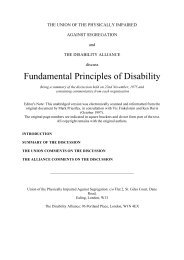Global-Report-Living-Colour-dr2-2
Global-Report-Living-Colour-dr2-2
Global-Report-Living-Colour-dr2-2
You also want an ePaper? Increase the reach of your titles
YUMPU automatically turns print PDFs into web optimized ePapers that Google loves.
Inclusive Communities = Stronger Communities<br />
GLOBAL REPORT ON ARTICLE 19: THE RIGHT TO LIVE AND BE INCLUDED IN THE COMMUNITY<br />
103<br />
including second order deinstitutionalization (See Table 10<br />
below). Another challenge is the separation from<br />
determining what a person wants and needs from the<br />
provision of those services and supports. In far too many<br />
places, eligibility and design of services and supports are<br />
made by the same entity providing them. This is clearly a<br />
conflict of interest. In other places people who have an<br />
intellectual disabilities risk losing their place to live if they<br />
don’t “behave”. This is entirely at the discretion of those in<br />
charge and with no recourse. In yet other places, people<br />
with intellectual disabilities remain segregated in large<br />
workshops or day programmes which are dependent upon<br />
the income from contracts for services with<br />
businesses or income from government for<br />
that person; thus the person who might want<br />
to do other things with their life is denied the<br />
choice and control to do so. For services and<br />
supports to be truly person centric, money<br />
from governments must be in tune with the<br />
wants and needs of the person. The CRPD is<br />
about the rights of persons with disability,<br />
not the rights of organizations providing<br />
services and supports. There is a big<br />
difference.<br />
In countries without institutions, efforts should<br />
be made to help policymakers, advocates and national and<br />
local governments determine and implement the path to<br />
fulfillment of the promises of Article 19 without resorting to<br />
building institutions. The temptation of creating large<br />
places for people with intellectual disabilities to live is great<br />
and on the surface a ready solution to supporting people.<br />
However we know from countless studies, exposés, the<br />
experience of policymakers and experts and conversations<br />
with people who were previously institutionalized that<br />
regardless of the amount of money spent, that institutions<br />
by their very existence, separate and segregate people with<br />
intellectual disabilities from their community, and from their<br />
family. In addition, once an institution is built or remodeled<br />
it takes decades, not years to build community capacity and<br />
to get people out and eliminate the institution as an option.



